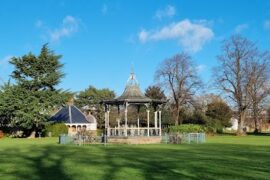Welcome to the World of Paddocks: A Parent’s Guide
Greetings, fantastic parents! Are you ready to embark on an adventurous journey into the great outdoors with your little ones? If you’ve got a child with a passion for all things equine, you’re likely curious about paddocks. Fear not! We’re here to guide you through the green pastures of understanding and managing paddocks, ensuring your young horse enthusiast can enjoy their hobby safely and joyfully.
What’s a Paddock, Anyway?
Before we dive hooves-first into the specifics, let’s get the basics trotting. A paddock is an enclosure used to contain horses or other livestock. It’s a safe space where your child’s equine friends can graze, exercise, and play without wandering too far off. Think of it as a delightful outdoor room for four-hoofed buddies!
Why Paddocks Are Important in Child Equine Education
- Safety: Paddocks provide a secure environment for both the horse and your child. It prevents unexpected sprints across vast, uncontrolled areas—or worse, busy roads!
- Exercise: These fenced-in spaces allow horses to move freely and maintain their fitness, crucial for a happy and healthy horse.
- Training ground: Paddocks serve as an excellent introduction for young equine enthusiasts to learn horse handling and care in a controlled setting.
Choosing the Right Paddock
Okay, so you’re convinced that a paddock is a stellar idea for your child’s equine companion, but how do you choose the right one? The size of the paddock, types of fencing, and the lay of the land are all vital considerations. Let’s gallop through these one by one:
Size Does Matter
The size of your paddock will depend on several factors, including the number of horses you wish to contain and the purpose of the space. If the paddock is for occasional use, a smaller area might be sufficient. However, if it’s going to be a primary space for your horses, think bigger. Expert tip: As a rule of thumb, one acre per horse is ideal to prevent overgrazing and promote ample exercise.
Fencing Fundamentals
Fencing is critical in a paddock, not just for keeping horses in but also for keeping anything potentially harmful out. It should be sturdy, visible, and free of sharp edges. Wooden fences are popular, but electric or vinyl fencing might be a good fit depending on your particular needs and concerns.
Location, Location, Location
Selecting a location for your paddock involves evaluating the terrain. Flat or gently sloping grounds prevent waterlogging and are preferable for your horse’s leg health. Also, consider the proximity to water sources, shelter, and feeding areas.
Creating a Safe Paddock Environment
Now that you’ve got the scoop on what a paddock is and what to consider when choosing one, let’s take a look at how to make it a safe environment for your child and their horse:
- Regular maintenance is key. Check fences for damage, clear any debris, and make sure gates securely close.
- Provide adequate shelter from the elements—rain, wind, or intense sun shouldn’t spoil the paddock experience.
- Ensure fresh water is always available. Hydration is just as important for horses as it is for excited kiddos fresh from a riding session.
- Consider the footing—good drainage and non-slip surfaces will prevent injuries and keep the area pleasant no matter the weather.
As you venture into the world of paddocks, remember, every good story needs a solid groundwork, and this is just the beginning of yours. By equipping yourself with this knowledge, you’re setting the stage for countless happy memories between your child and their four-legged friend. So, grab your boots, and let’s get ready to tread into more exciting details about paddock care, management, and the joy it can bring to your family’s life!

Five Things Parents Should Know in Preparing Paddocks
1. Understanding Horses’ Habits and Needs
Before setting up a paddock, it’s essential to understand the behavior and requirements of horses. These majestic animals need plenty of room to roam, social interaction, and regular exercise to stay healthy and happy. Learning about their grazing habits, social structures, and exercise needs will help you create a paddock that suits their natural behaviors.
2. Selecting the Best Materials for Durability and Safety
When it comes to building your paddock, using quality materials can make all the difference. Durable, horse-safe fencing material like properly treated wood or specific horse fencing can ensure longevity and prevent injuries. Non-toxic plants and safe, stable ground cover are also vital, as horses tend to explore their environment with their mouths and hooves.
3. Planning for the Weather and Seasonal Changes
Horses require protection from harsh weather, be it the scorching sun or freezing winter cold. Strategic placement of natural windbreaks or man-made shelters can provide necessary reprieve from the elements. Additionally, consider the drainage system for rainfall and the access to shade during hotter seasons.
4. Getting the Right Equipment
Equipping your paddock with the right tools is as crucial as the layout itself. Items like troughs for water, feeders, and hay racks should be robust and sturdy. For maintenance, keeping on hand equipment such as rakes, shovels, and wheelbarrows will simplify the process of keeping your paddock in tip-top shape.
5. Learning Basic Horse Care and First Aid
As a parent, understanding basic horse care is vital. Knowing how to perform regular health checks, spot signs of illness, and administer first aid can be life-saving. Having a well-stocked equine first aid kit and the contact details of a reputable vet can ensure you’re ready to handle any emergencies that arise.
Remember: Preparing a paddock is not just about the physical space. It’s about creating a nurturing environment for your child’s equine companion where they can learn, play, and grow together safely. With the right knowledge and preparation, you’re on your way to giving your child an invaluable, hands-on education in the responsibilities and joys of horse stewardship!
. For more information see here
Disclaimer
The articles available via our website provide general information only and we strongly urge readers to exercise caution and conduct their own thorough research and fact-checking. The information presented should not be taken as absolute truth, and, to the maximum extent permitted by law, we will not be held liable for any inaccuracies or errors in the content. It is essential for individuals to independently verify and validate the information before making any decisions or taking any actions based on the articles.




